PERIKLES (c. 490–429 BC) Ancient Greek politician, strategist...

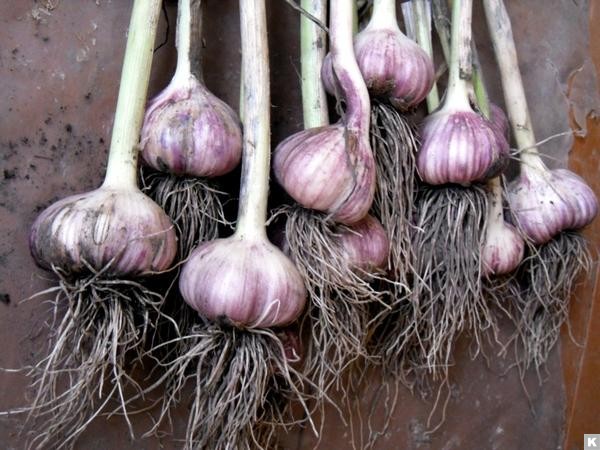
Summer residents and gardeners know that it is better to plant garlic in the fall and then you won’t have to buy it in the store in the summer. In order for the harvest of garlic to be good, it is necessary to choose the right time to plant it.
Garlic is a very healthy vegetable, it strengthens the immune system in case of colds and gives a bright and aromatic taste and smell to cooked dishes. Garlic is also added to pickles, marinades, sauces, as well as in the preparation of meat, poultry and fish.

Garlic can be planted twice a year. But in order to get a rich summer harvest, it is best to plant a vegetable in late autumn. This period is called winter planting. Garlic planted at this time is large in size and has a pink-purple color of the shell, and inside there is a hard core. Also, this garlic has a bright and juicy taste. You can plant garlic with whole cloves, single-clove bulbs and garlic shifts. The best time for planting garlic is September. Since it is important to plant a vegetable before the onset of cold weather and frost, otherwise the garlic will not have time to take root and take root and, most likely, will die.
The place for planting garlic should be chosen dry, with good lighting and preferably without through wind. The soil should be fertile, in acidity - clay or neutral. It is important to choose large, healthy cloves for planting. It is recommended to divide the head of garlic into cloves immediately before planting, otherwise the garlic may dry out. Before planting, you can peel the garlic, but this is not necessary. And everyone decides for himself whether to do it or not.

Many summer residents and gardeners buy a lunar calendar for the whole year, as they believe that it is the location of the moon that affects the time of planting and the further growth of plants. In the lunar calendar, there is a concept of favorable and unfavorable days. And for those who want to harvest a bountiful harvest of garlic, it is also worth paying attention to.
The location of the moon also has a great influence on the growth of garlic. The lunar calendar categorically does not recommend planting garlic on a new moon or a full moon. These days, the sap of the plant is at the top or at the root, which slows down the growth of the plant.
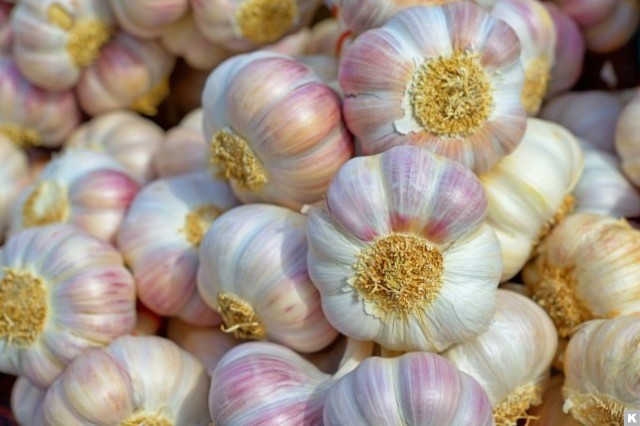
By lunar calendar most auspicious days in September, there are 7, 8, 9, 23, and 24 September for planting garlic. In October, it is best to choose the 5th, 6th, 20th and 22nd. Whoever does not have time to plant garlic in the first two autumn months, planting is also allowed in November, and this month it is recommended to choose such days - November 1, 2, 16, 17, 29, and 30 November. Only planting garlic in November cannot guarantee a good and rich harvest next year.
But when to plant garlic so that in the summer you don’t have to buy it in a store, but have the opportunity to collect your own, fresh from the garden? WANT.ua will tell you when to plant garlic in 2017 so that the summer harvest will please you. And if you have not yet had time to freeze garlic or onions for the winter, we suggest that you familiarize yourself with the material on how best to do this.
Garlic has many useful properties, every summer resident grows it.
However, not everyone manages to get a good harvest.
In order to have excellent teeth in the summer, you need to properly plant garlic in the fall.
And you need to start with the choice of planting material, preparing the beds and much more.
To begin with, the gardener must decide what kind of garlic he wants to grow. The fact is that this culture is divided into several types:
Spring garlic;
Winter garlic.
These species differ from each other externally in the number and shape of teeth.
1. Winter garlic cloves are large, the same size. They are evenly distributed around the base in one row.
2. Varieties of winter garlic give a flower arrow that forms bulbs.
Winter garlic is dug up early, used for summer consumption or for harvesting. For longer storage, varieties of spring garlic are grown. This article will focus on the cultivation of winter garlic.
Some gardeners prefer to grow spring garlic as it has a longer shelf life. However, there are a number of advantages to planting winter garlic.
1. Saving time during spring work. The landing dates are extended, which allows you to take your time and prepare well for the procedure. In the spring there is too much work in the garden, there is no time for high-quality preparation of beds and material, and in autumn it is much more.
2. Winter garlic is not afraid of frost, while return frosts can destroy the tender shoots of spring garlic.
3. Planting material is quite large, and a small fraction of spring garlic often dries out by the time of planting.
4. Winter garlic is undemanding in care, since soil moisture is sufficient for its development.
5. Winter varieties of garlic are more resistant to pests, less affected by various diseases.
6. The yield of winter garlic is much higher than that of spring garlic.
7. Harvesting takes place a month earlier, which allows garlic to be used for summer consumption.
An important factor on the way to harvest is the variety that is cultivated on the site. Experienced summer residents prefer purple-striped varieties of garlic. In the people they are called so for the color of the scales. Indeed, these varieties are the most resistant to disease and frost. Commodity quality heads at the highest level. Bulbs are formed weighing about 150 grams each.
Gribovsky Jubilee;
Komsomolets;
Polessky;
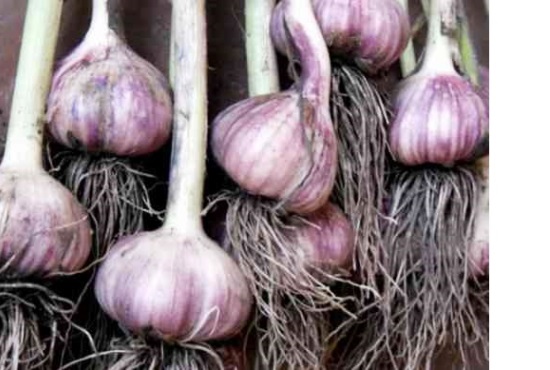
An experienced gardener knows that you can only get a good harvest only when the planting is done on time. Many people confuse the types of garlic and plant them at the wrong time, which reduces the quality of the crop and its quantity.
For an early harvest, planting of winter garlic is carried out in the fall. If it is planted in the spring, then the teeth will not tie, but lush, green tops will grow. The formation of a commodity head occurs under certain conditions.
Autumn dates winter landing garlic for each region will be different, but following some rules will help you accurately determine the auspicious time.
1. It is better to plant the prepared material a month before the expected frost. It takes about 3 weeks for the teeth to root.
2. Under the conditions of the middle lane, the period of autumn planting of garlic falls on the end of September - the beginning of October. In a month, the teeth will form a powerful root system, which is the key to a bountiful harvest.
Cold and frost are not terrible for garlic if the root system has developed sufficiently, but late planting leads to the fact that the roots are poorly formed. This leads to the fact that the teeth will die in the winter.
Important! You should not rush into planting too much; winter garlic should not be allowed to germinate in the fall.
The harvest of the next year also depends on the quality of the teeth. All planting material undergoes strict processing and preparation.
For planting, well-dried heads are chosen, which are carefully divided into teeth, trying not to damage the scales.
The selected material is sorted. The teeth must be healthy, with no visible signs of disease, stains, cracks or injuries. Spoiled teeth will rot and can infect the entire garden.
It is better to plant those varieties that are cultivated in the region. This will provide a more stable harvest.
All teeth are pre-treatment. Garlic is soaked for several minutes in a salt solution. To do this, add 3 tbsp to 5 liters of water. tablespoons of table salt.
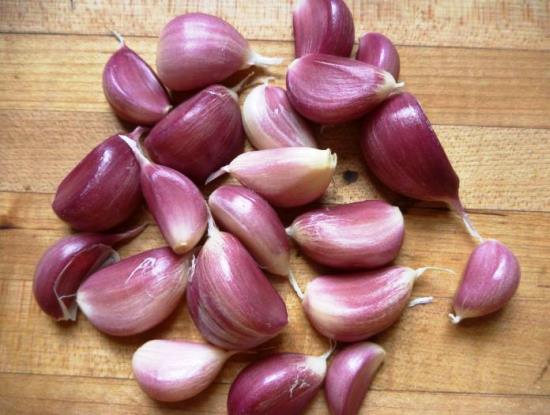
Advice! If you want to grow a crop of large garlic, then only large cloves are selected for autumn planting.
Experienced summer residents for disinfection of planting material use a solution of potassium permanganate, the drug "Fitosporin-M", ash infusion. Prepared and sorted teeth stand for about 30 minutes.
Another factor affecting yield is the soil in which garlic is grown. The quality of the resulting heads directly depends on its structure and composition. Therefore, special attention should be paid to soil preparation. What does it mean?
1. The bed for the autumn planting of garlic is prepared in advance. As a rule, a month before the intended landing.
2. Too dense soil is not suitable for growing garlic, so it must be loosened.
3. The ideal soil for garlic is loam.
4. A good harvest is obtained only in a land rich in nutrients. Fertilizers will help improve the composition of the soil.
The amount and type of fertilizer depends on the soil in which the cultivation is planned. Mineral complexes are introduced into loamy soil for digging. For 1 sq. meter:
1 glass of dolomite flour;
1 st. a spoonful of superphosphate;
1 st. spoon of nitrophoska
You can enrich the soil with organic fertilizers. Suitable humus or compost, one bucket per 1 sq. m. beds.
Other types of soil fertilize differently.
1. Clay soil is enriched with peat. 1 bucket per 1 sq. garden meter.
2. Peatlands are bred with loamy soil.
3. Sandy soils need fertilizers like loams, but with the addition of peat.
All fertilizers are applied under the digging of the beds. It is necessary to loosen the earth to a depth of 20 cm. After that, the landing site is formed and compacted.
The finished bed is watered with a disinfectant solution. For this, copper sulfate is used. In 10 liters of water, dilute 50 gr. drug. The bed is watered and covered with a film until planting.
Light and loose earth, which is enriched with nutrients, allows you to grow large and healthy garlic.
A garden bed with garlic is best placed in a well-lit place. This culture does not like stagnant water, excessive moisture contributes to the development of fungal diseases. If there is no other place, then you can correct the situation by arranging high beds.
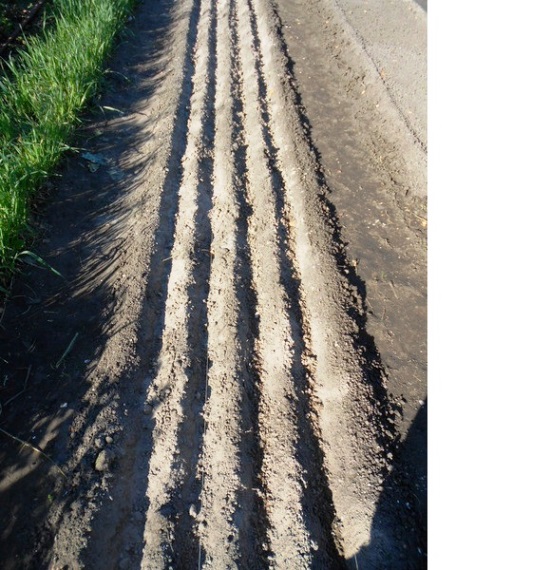
Most often, garlic is grown in rows in the garden. The distance between them is about 25-30 cm, which makes it easier to care for the culture. The teeth are planted in rows at a distance of about 10 cm from each other. However, this depends on the size of the planting material. Larger cloves need more space, while smaller ones can be planted more tightly.
The depth of planting the cloves depends on the period of planting the garlic. In autumn, furrows are made deeper for winter sowing, about 10 cm. Insufficient planting depth will cause the garlic to freeze. In harsh climates, gardeners practice mulching the beds with straw or dry grass. However, in early spring, the shelter must be removed.
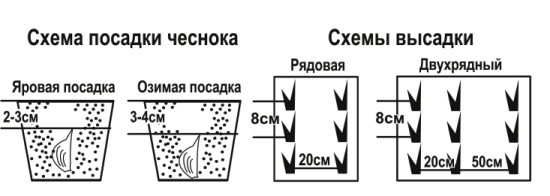
Furrows for planting are made parallel to each other, and the teeth are planted strictly vertically, bottom down. There is nothing difficult in the formation of beds, adhering to all the rules, you can expect a good harvest next summer.
1. After processing, planting material must be planted immediately. If this is not possible, then it is better to store it for no longer than a week. Further, the percentage of germination of teeth decreases.
2. Experienced gardeners know how the proximity of crops in the garden affects the yield. The best precursors of garlic are greens, root vegetables, cucumbers, tomatoes, eggplant, cabbage and zucchini. You can grow garlic in the same garden as strawberries, cucumbers and tomatoes.
3. You can not plant garlic after onions. You can return the culture to its original place after three years.
4. Strict adherence to the timing of winter planting garlic in the fall.
5. High-yielding proven varieties are selected for planting. Do not expect a good harvest from a low-yielding variety.
6. Timely updating of planting material. Garlic, like any other culture, gradually degenerates. Once every three years, you need to rejuvenate the variety. To do this, leave a few arrows, from which bulbs are obtained. In the first year, single teeth grow from them. Having landed single-toothed teeth in the fall on the garden, in the summer they get commodity heads.
7. Compliance with the terms of harvesting. They differ in each region. You can determine the exact time using the arrow. As soon as it burst and bulbs appeared, the garlic ripened.
8. Breaking out the arrows allows you to grow larger heads of garlic, speeds up the ripening process.
9. Compliance with the exact mode of watering. In the first phase of growth, winter garlic is watered abundantly, and by the end of the growing season, watering is stopped.
10. Mulching beds with garlic favorably affects the formation of heads. Mulch helps to retain moisture, which is necessary for the formation of large teeth.
Advice! If the beds are cleared up in the second half of June, this contributes to the formation of a more even and larger head.
Despite all the tricks, growing large garlic without the necessary dressings will not work. During the growing season, winter garlic needs to be fed several times.
The first feeding is carried out at the beginning of the growing season, when the first leaves appeared. During this period, nitrogen fertilizers are used. Experienced gardeners water the bed with infusion of mullein or chicken manure. In 10 liters of water insist 1 kg of the substance. After the completion of the fermentation process, the solution is diluted with water in a ratio of 1:10, 10 parts of water are taken for 1 part of the infusion.
The second top dressing is carried out at the time of head formation. The same solution is used.
Harvesting must take place at a certain time, which affects the quality. Winter garlic is dug up when the leaves begin to turn yellow. Loosen the bed with a pitchfork, carefully removing the garlic. The harvested crop is shaken off the ground and dried.
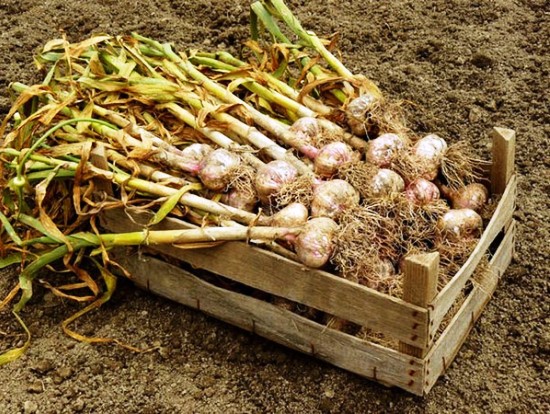
You need to dry the garlic in the shade under a canopy. Stems and roots should not be cut off. They should dry on their own. During the drying process, all the nutrients from the stem descend into the head. During the drying of the crop, it is periodically inspected and ted. Particular attention is paid to the lower layers, as they can flow.
When the garlic is well dried out, the stems are cut to a height of 10 cm, the remnants of dry roots are removed and the heads are stored for storage. In this form, the crop is stored until planting.
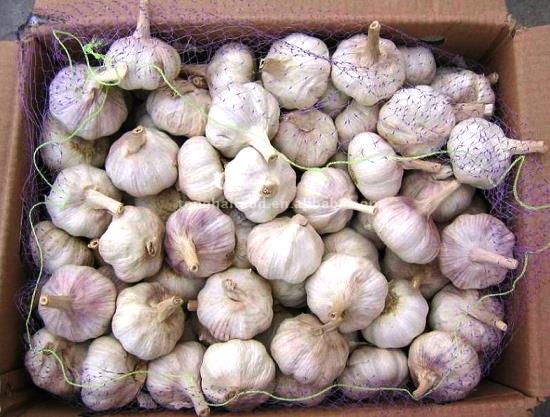
In conclusion, we can say that garlic is an unpretentious culture. Its cultivation is not a hassle, but it is imperative to take into account all the above rules to get a good harvest of winter garlic.
AdvertisingGarlic, as a garden crop, is not only useful for humans. He is a very positive neighbor for many vegetable crops, because its smell repels many pests - from slugs and all kinds of caterpillars to drillers of various types and even moles. It turns out that fungal diseases recede under the onslaught of garlic influence.
In addition, many plants, both garden and garden, will be happy to be next to garlic. Among them:
Bulbous plants such as crocuses, tulips, gladioli;
Roses and berry bushes (any currant, as well as raspberries and gooseberries);
Onions, cucumbers, tomatoes, eggplants, potatoes;
Strawberry.
Cabbage, beans and other legumes will not be happy with such a neighborhood, due to the fact that the presence of garlic in close proximity to the beds with these plants inhibits their growth and development. But garlic planted after these crops will give a good harvest due to the specific substances that fill the ground during the growth of the above plants and pumpkin.
First of all, you need to prepare the seed material, which is divided into large and hard cloves. Such a garlic base is required, because if the seeds are small or soft, then the result will not please you accordingly. When you sort out the teeth, you need to check them for various kinds of damage, which should not be.
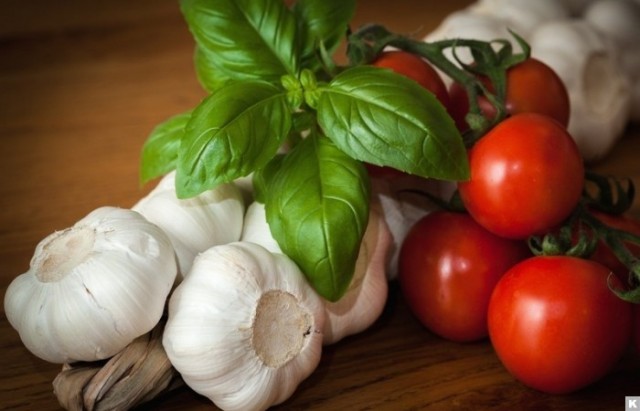
It is better to plant pre-treated seeds in a weak manganese solution. To do this, water is poured into a deep bowl, a little potassium permanganate is added, the selected seed material is mixed and laid. It is not necessary to withstand for a long time, five minutes is enough, and after that you can plant garlic before winter.
Proper planting of the material makes it easy to handle the crop and effectively affects the yield. Therefore, before growing one, you should pay attention to some of the care requirements for this plant and know how to properly plant garlic before winter.
The beds for seeds are broken at a distance of 25 centimeters from each other. The distance of the teeth between themselves should be at least 15 centimeters, even if there is little space. The fact is that when garlic is planted at a closer distance, it will not be large in size, since it will not have enough proper nutrition.
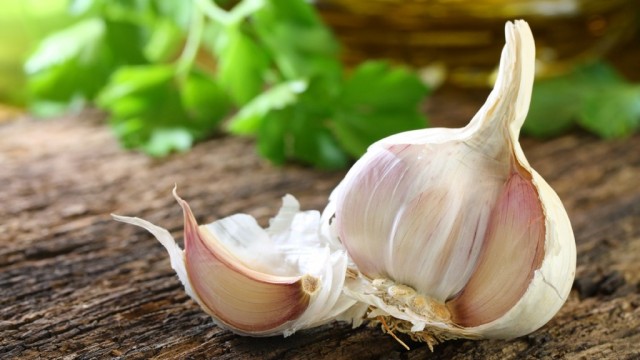
In winter cold, the teeth of the plant should feel good and comfortable in the ground, so the planting depth should be 10-15 centimeters. When garlic is planted before winter in the Moscow region, they adhere to just such rules, because, in fact, there are no severe frosts in this region, when compared with some other regions.
Too early planted garlic will sprout, which should not be allowed categorically, and garlic planted too late will not have time to take root and freeze, therefore it is so important to observe the planting dates of winter varieties verified by many years of experience.
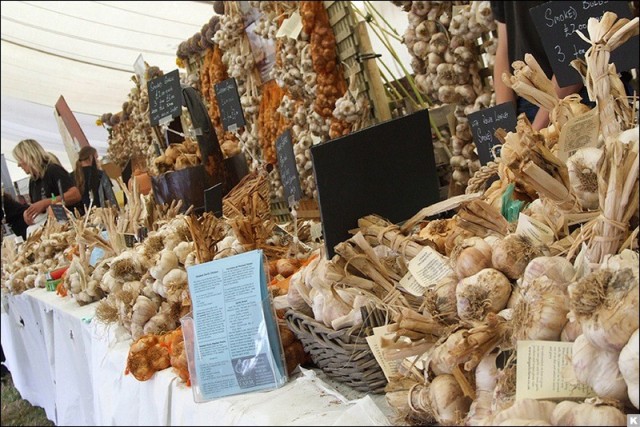
Before you determine the site for winter garlic, you need to know after which you can plant garlic, that is, which crops can precede garlic, and after which it will not grow. Garlic will grow best after annual vegetables with a short growing season - cucumbers, peppers, eggplants, pumpkins, squash, cereals or berry bushes. It is not recommended to plant garlic in the area where root crops grew - their crop is harvested late, and the soil depleted by root crops is unlikely to have time to recover.
Can you plant garlic after garlic? Absolutely not. Just like after the bow. The principle of fruit change suggests that you will be able to grow garlic in the place where it grew in the current year no earlier than in three to four years.
Unlike spring garlic, which reproduces only by cloves, winter garlic reproduces by both cloves and bulbs. In order to grow a full-fledged bulb from a bulb, it will take two years, and from a clove you can get a large onion the next year after planting.
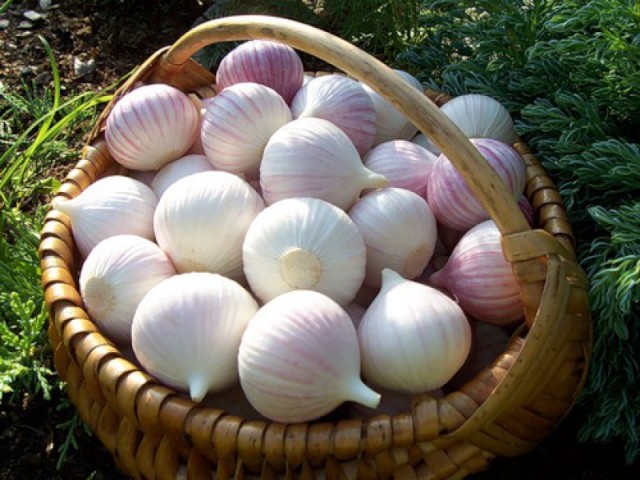
Before planting garlic in the fall, the seed is sorted out, discarding damaged, small and diseased teeth, as well as those in which the shell is broken, then high-quality teeth are disinfected for 2 hours in ash liquor - a solution of 400 g of ash in two liters of water, boiled in for half an hour and then chilled. Instead of ash lye, for disinfecting teeth, you can use a two-minute treatment of the seed in a saline solution (3 tablespoons per 5 liters of water), followed by disinfection for a minute in a solution of copper sulfate (1 teaspoon per 10 liters of water).
Spotted a typo or mistake? Select the text and press Ctrl+Enter to tell us about it.